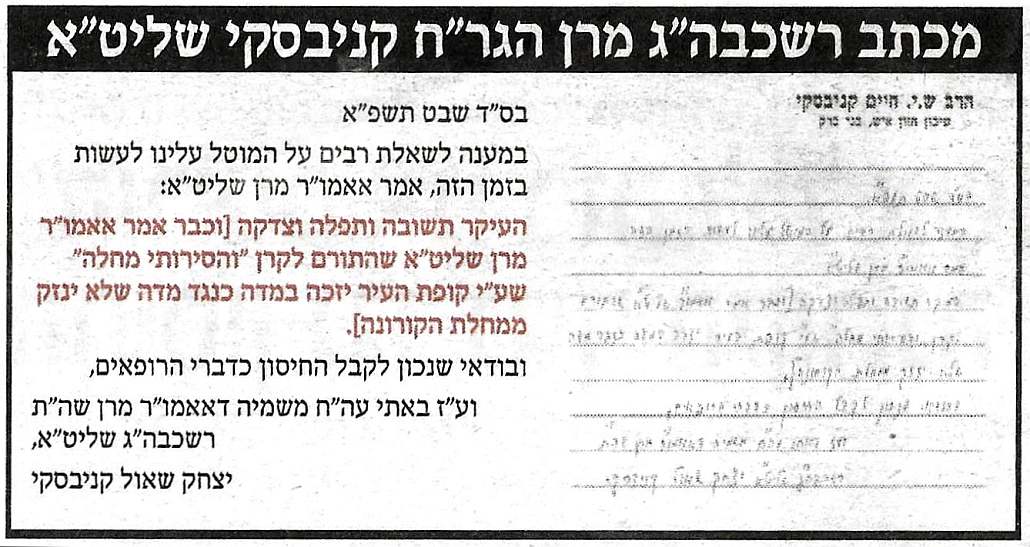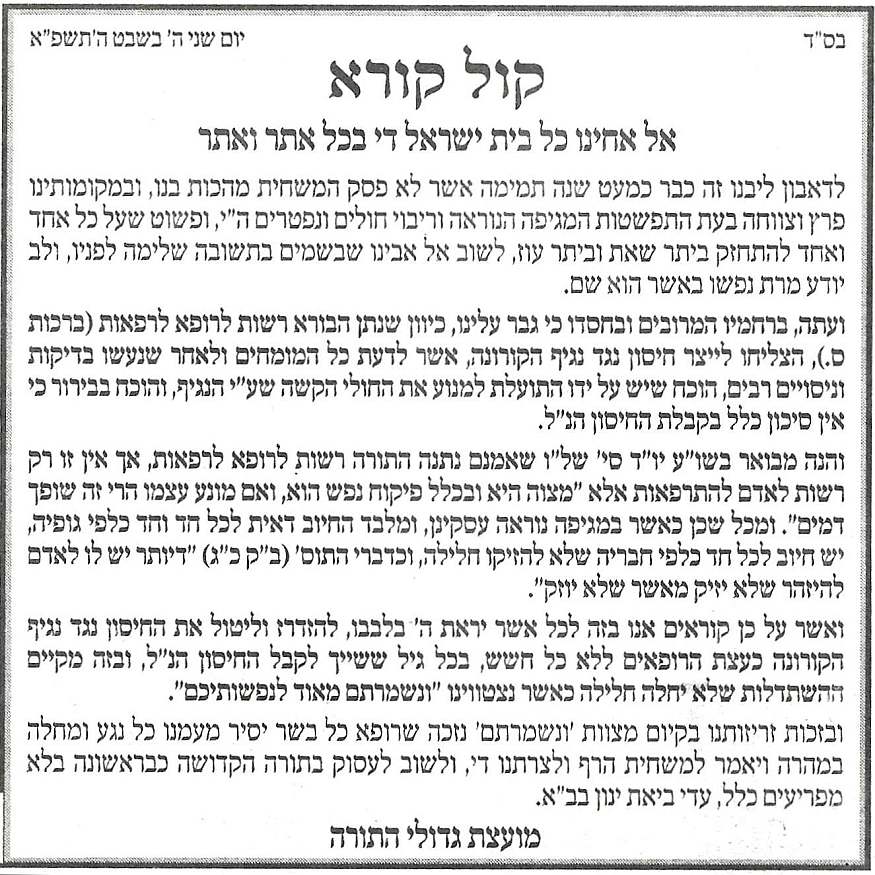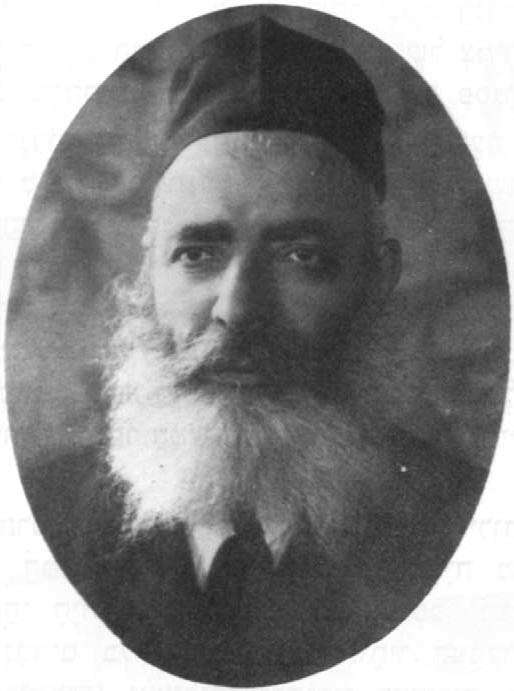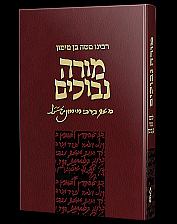| |
This Google Custom Search looks only
in this website.
Recent Letter from HaRav Chaim Kanievsky shlita
In reply to the question of people regarding what is expected of us in these times, my father said:
"The main thing is teshuva, prayer and tzedokoh....

Kol Korei — A Public Cry to Vaccinate

The Vaccine Protects Better than Recovery
Encouraging news from the Health Ministry: the level of antibodies resulting from the Pfizer vaccine is higher than in people who have recovered naturally...
The Power of Tefillah in a Time of Pandemic
The Mirrer Mashgiach HaRav Yeruchom ("Daas Torah" on Mishpotim) clarifies very meaningfully the subject of epidemic, teaching us a straightforward objective Torah truth:
We always thought that disease in general visits a person because of a certain flaw in his makeup. It is more true to think that illness strikes a person with a definite purpose, each one disparately.

A scholar of American anti-Semitism explains the hate symbols present during the US Capitol riot
We are publishing this article because it shows the serious issues and symbols of antisemitism that were part of the mob scene on January 6 at the US Capitol. It is important to know what we are faced with.
One of the many horrifying images from the Jan. 6 rampage on the U.S. Capitol shows a long-haired, long-bearded man wearing a black "Camp Auschwitz" T-shirt emblazoned with a skull and crossbones, and under it the phrase "work brings freedom" - an English translation of the Auschwitz concentration camp motto: "Arbeit macht frei."
These and related images, captured on television and retweeted on social media, demonstrate that some of those who traveled to Washington to support President Donald Trump were engaged in much more than just a doomed effort to maintain their hero in power.
As their writings make clear to me as a scholar of American anti-Semitism, some among them also hoped to trigger what is known as the "Great Revolution," based on a fictionalized account of a government takeover and race war, that, in its most extreme form, would exterminate Jews.

The Yom Tov Stern Family - Stars in the Jewish Firmament
Part II
In the Service of the Community
When Chaya Esther Stern passed away on January 27, 1998, it was a sad moment not only for the large Stern family spread out over the U.S. and Israel, but it signaled the sunset of another generation of a family that had resolutely stood up to the trials of early America while maintaining and promoting an authentic Jewish environment. In the pre-War years, Yom Tov and Chaya Esther Stern raised her children with all-encompassing devotion, and ran her home so that it was a lighthouse of chesed and wisdom. After Yom Tov's passing and Chaya Esther's move to Eretz Yisroel, she naturally assumed the position of matriarch for her large family because of the reverence that all her descendants felt toward her.
Educational Principles
Rain and Kinneret Watch
by Dei'ah Vedibur
Staff
Our weekly report of the rain and the level of the Kineret -
Winter, 5781.
* * *
|
From Our Archives |
|
The Disease No One Talks About (Mental and Emotional Problems)
YATED COLUMNIST CHAIM WALDER addresses this problem:
Many times there are problems in health and mental health in particular, which are ignored or covered up during the adolescent / shidduchim age. The reasons for this attitude are many, but one basic point has been brought up. If the adolescent gets therapy, he may be labeled and his shidduchim chances will be compromised.
Result? 1) The person in question suffers and does not receive the therapy/ guidance/ medication needed.
2) The problems usually erupt after the person is `safely' married and the spouse must pay the penalty. The marriage may be jeopardized.
What can be done to alleviate this situation?
|
My Rosh Yeshiva, My Mentor, My Father: In memory of HaRav Chaim Kreiswirth, zt"l, on his first Yahrtzeit
Compiled by Talmidim
A Personal Loss
A year later, the entire world is still aching over the loss of one of our greatest Torah giants. The distress has not subsided, and we are still staggering from the blow.
HaRav Chaim Kreiswirth was one of the greatest Torah giants of our generation. He was known as a godol hador, one of the seridei dor dei'ah, a remnant of the great previous generation. Our luminaries, the Devar Avrohom, the Mekor Boruch and others, marveled at his genius, at his total command of Talmud Bavli and Yerushalmi with commentaries, together with the deepest levels of logic and understanding. He clearly had pi shnayim beruach, a double measure of spiritual abilities, and was a brilliant thinker in both halochoh and aggadah. But most of all, he overflowed with life, pnimiyus and love of Torah.
At the same time, he was also av beis din and moroh de'asra of Antwerp, Belgium. Under his remarkable leadership, Antwerp was transformed after the Holocaust into a remarkable city.
HaRav Kreiswirth earned international acclaim as the father of the fatherless because he cared for the orphaned, the unfortunate, and the needy. He felt their pain. He understood their distress. He helped them financially and supported them emotionally. The Rav did nothing through agents or assistants; he shouldered the heavy burden of supporting the needy alone, with the greatest mesirus nefesh.
|
Tu Bishvat: Man as a Tree
by HaRav Arye Leib Shapira
In the first part, HaRav Shapira quoted the Chidushei HaRim and others who say that the essence of Tu Bishvat is chidushei Torah. They also note that the trees grow on Tu Bishvat based on the rain that falls earlier. The Maharal says that the cycle of crops that is referred to in the Regolim of the year parallels the cycle of man's development, from the beginning at Pesach to the final ingathering on Succos. Why this parallel? Because Hashem wants to tell us that all the material world has a spiritual parallel; when we are showered with rain down here, there is a corresponding spiritual blessing being showered upon us Above. That also underlies the entire expression of the Torah which is written referring to material blessings but alluding to the parallel spiritual blessings.
Why We Eat Fruit of Eretz Yisroel on Tu Bishvat
With this idea we can understand the custom of eating fruit of Eretz Yisroel on Tu Bishvat (see Moed Lekol Chai), for Chazal tell us that since Eretz Yisroel is a special place where the Shechinoh finds a home, its residents merit a special insight into the Torah: "'The beginning (or "head") of the dust of the world' (tevel) (Mishlei 8:26) -- this is Eretz Yisroel, the most beloved of all countries and the one created first."
|
| |
POPULAR
EDITORIALS
Av, 5765 - Kislev 5766 (August-December 2005)
|






.jpg)



